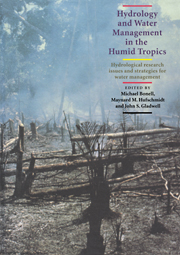 Hydrology and Water Management in the Humid Tropics
Hydrology and Water Management in the Humid Tropics Published online by Cambridge University Press: 23 December 2009
ABSTRACT
The characteristics and general ecology of tropical fresh waters are outlined, with reference to the physical and chemical regulation of aquatic environments and the differentiation and dynamics of their communities.
Solar radiation income is the most distinctive and driving variable which leads to relatively high and seasonally-maintained temperatures, with relatively small differentials with depth. This thermally controlled density stratification is sensitive to changes in the energy balance and wind stress, which, in turn, controls chemical and biological stratification. Indefinitely prolonged stratification is common in very deep lakes, and well developed seasonal cycles are frequent, even in equatorial water bodies.
The primary chemical inputs are dominated by rock weathering and atmospheric gaseous exchange, although numerous secondary pathways and controls exist. Dissolved constituents are separable into major, minor and trace elements; gases; and organic compounds. The total ionic content varies widely, but is generally low in the humid tropics. Important interactions between gaseous (CO2) and ionic constituents occur via the CO2/HCO3-/CO32- system, with implications for pH buffering, Ca2+ removal as CaCO3, P removal as apatite, and the biological supply of CO2. Inorganic forms of the nutrient elements N, P and Si are subject to biological depletion; in tropical regions low concentrations of nitrate and high ones of dissolved Si are prevalent. Anoxia is associated with accumulations of the chemically reduced gases CH4, H2S and NH3 with their derivatives, both in very deep and very shallow (swamp) waters. “Black water” rivers carry high concentrations of organic material. The relationship of concentration with river flow rate varies with different chemical constituents, as do upstream-downstream relationships.
To save this book to your Kindle, first ensure [email protected] is added to your Approved Personal Document E-mail List under your Personal Document Settings on the Manage Your Content and Devices page of your Amazon account. Then enter the ‘name’ part of your Kindle email address below. Find out more about saving to your Kindle.
Note you can select to save to either the @free.kindle.com or @kindle.com variations. ‘@free.kindle.com’ emails are free but can only be saved to your device when it is connected to wi-fi. ‘@kindle.com’ emails can be delivered even when you are not connected to wi-fi, but note that service fees apply.
Find out more about the Kindle Personal Document Service.
To save content items to your account, please confirm that you agree to abide by our usage policies. If this is the first time you use this feature, you will be asked to authorise Cambridge Core to connect with your account. Find out more about saving content to Dropbox.
To save content items to your account, please confirm that you agree to abide by our usage policies. If this is the first time you use this feature, you will be asked to authorise Cambridge Core to connect with your account. Find out more about saving content to Google Drive.